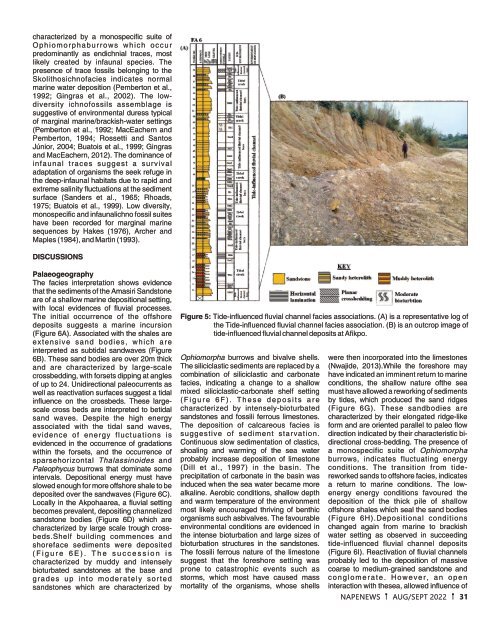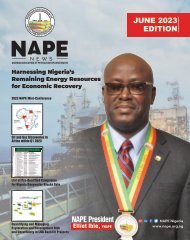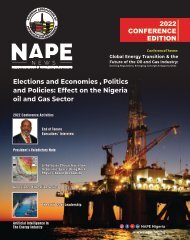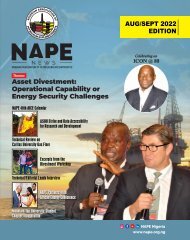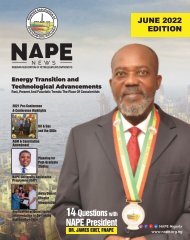Create successful ePaper yourself
Turn your PDF publications into a flip-book with our unique Google optimized e-Paper software.
characterized by a monospecific suite of<br />
Ophiomorphaburrows which occur<br />
predominantly as endichnial traces, most<br />
likely created by infaunal species. The<br />
presence of trace fossils belonging to the<br />
Skolithosichnofacies indicates normal<br />
marine water deposition (Pemberton et al.,<br />
1992; Gingras et al., 2002). The lowdiversity<br />
ichnofossils assemblage is<br />
suggestive of environmental duress typical<br />
of marginal marine/brackish-water settings<br />
(Pemberton et al., 1992; MacEachern and<br />
Pemberton, 1994; Rossetti and Santos<br />
Júnior, 2004; Buatois et al., 1999; Gingras<br />
and MacEachern, 2012). The dominance of<br />
infaunal traces suggest a survival<br />
adaptation of organisms the seek refuge in<br />
the deep-infaunal habitats due to rapid and<br />
extreme salinity fluctuations at the sediment<br />
surface (Sanders et al., 1965; Rhoads,<br />
1975; Buatois et al., 1999). Low diversity,<br />
monospecific and infaunalichno fossil suites<br />
have been recorded for marginal marine<br />
sequences by Hakes (1976), Archer and<br />
Maples (1984), and Martin (1993).<br />
DISCUSSIONS<br />
Palaeogeography<br />
The facies interpretation shows evidence<br />
that the sediments of the Amasiri Sandstone<br />
are of a shallow marine depositional setting,<br />
with local evidences of fluvial processes.<br />
The initial occurrence of the offshore<br />
deposits suggests a marine incursion<br />
(Figure 6A). Associated with the shales are<br />
extensive sand bodies, which are<br />
interpreted as subtidal sandwaves (Figure<br />
6B). These sand bodies are over 20m thick<br />
and are characterized by large-scale<br />
crossbedding, with forsets dipping at angles<br />
of up to 24. Unidirectional paleocurrents as<br />
well as reactivation surfaces suggest a tidal<br />
influence on the crossbeds. These largescale<br />
cross beds are interpreted to betidal<br />
sand waves. Despite the high energy<br />
associated with the tidal sand waves,<br />
evidence of energy fluctuations is<br />
evidenced in the occurrence of gradations<br />
within the forsets, and the occurrence of<br />
sparsehorizontal Thalassinoides and<br />
Paleophycus burrows that dominate some<br />
intervals. Depositional energy must have<br />
slowed enough for more offshore shale to be<br />
deposited over the sandwaves (Figure 6C).<br />
Locally in the Akpohaarea, a fluvial setting<br />
becomes prevalent, depositing channelized<br />
sandstone bodies (Figure 6D) which are<br />
characterized by large scale trough crossbeds.Shelf<br />
building commences and<br />
shoreface sediments were deposited<br />
( F i g u r e 6 E ) . T h e s u c c e s s i o n i s<br />
characterized by muddy and intensely<br />
bioturbated sandstones at the base and<br />
grades up into moderately sorted<br />
sandstones which are characterized by<br />
Figure 5: Tide-influenced fluvial channel facies associations. (A) is a representative log of<br />
the Tide-influenced fluvial channel facies association. (B) is an outcrop image of<br />
tide-influenced fluvial channel deposits at Afikpo.<br />
Ophiomorpha burrows and bivalve shells.<br />
The siliciclastic sediments are replaced by a<br />
combination of siliciclastic and carbonate<br />
facies, indicating a change to a shallow<br />
mixed siliciclastic-carbonate shelf setting<br />
( F i g u r e 6 F ) . T h e s e d e p o s i t s a r e<br />
characterized by intensely-bioturbated<br />
sandstones and fossili ferrous limestones.<br />
The deposition of calcareous facies is<br />
suggestive of sediment starvation.<br />
Continuous slow sedimentation of clastics,<br />
shoaling and warming of the sea water<br />
probably increase deposition of limestone<br />
(Dill et al., 1997) in the basin. The<br />
precipitation of carbonate in the basin was<br />
induced when the sea water became more<br />
alkaline. Aerobic conditions, shallow depth<br />
and warm temperature of the environment<br />
most likely encouraged thriving of benthic<br />
organisms such asbivalves. The favourable<br />
environmental conditions are evidenced in<br />
the intense bioturbation and large sizes of<br />
bioturbation structures in the sandstones.<br />
The fossili ferrous nature of the limestone<br />
suggest that the foreshore setting was<br />
prone to catastrophic events such as<br />
storms, which most have caused mass<br />
mortality of the organisms, whose shells<br />
were then incorporated into the limestones<br />
(Nwajide, 2013).While the foreshore may<br />
have indicated an imminent return to marine<br />
conditions, the shallow nature ofthe sea<br />
must have allowed a reworking of sediments<br />
by tides, which produced the sand ridges<br />
(Figure 6G). These sandbodies are<br />
characterized by their elongated ridge-like<br />
form and are oriented parallel to paleo flow<br />
direction indicated by their characteristic bidirectional<br />
cross-bedding. The presence of<br />
a monospecific suite of Ophiomorpha<br />
burrows, indicates fluctuating energy<br />
conditions. The transition from tidereworked<br />
sands to offshore facies, indicates<br />
a return to marine conditions. The lowenergy<br />
energy conditions favoured the<br />
deposition of the thick pile of shallow<br />
offshore shales which seal the sand bodies<br />
(Figure 6H).Depositional conditions<br />
changed again from marine to brackish<br />
water setting as observed in succeeding<br />
tide-influenced fluvial channel deposits<br />
(Figure 6I). Reactivation of fluvial channels<br />
probably led to the deposition of massive<br />
coarse to medium-grained sandstone and<br />
c o n g l o m e r a t e . H o w e v e r , a n o p e n<br />
interaction with thesea, allowed influence of<br />
NAPENEWS AUG/SEPT <strong>2022</strong> 31


